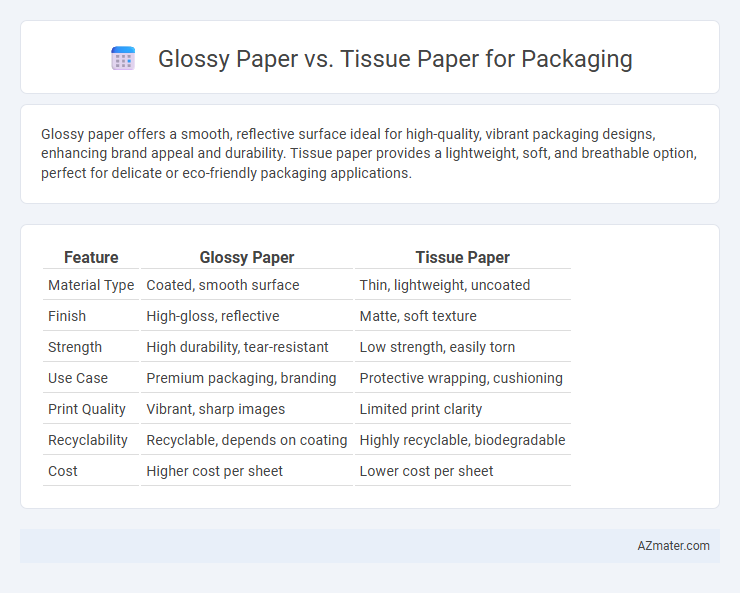Glossy paper offers a smooth, reflective surface ideal for high-quality, vibrant packaging designs, enhancing brand appeal and durability. Tissue paper provides a lightweight, soft, and breathable option, perfect for delicate or eco-friendly packaging applications.
Table of Comparison
| Feature | Glossy Paper | Tissue Paper |
|---|---|---|
| Material Type | Coated, smooth surface | Thin, lightweight, uncoated |
| Finish | High-gloss, reflective | Matte, soft texture |
| Strength | High durability, tear-resistant | Low strength, easily torn |
| Use Case | Premium packaging, branding | Protective wrapping, cushioning |
| Print Quality | Vibrant, sharp images | Limited print clarity |
| Recyclability | Recyclable, depends on coating | Highly recyclable, biodegradable |
| Cost | Higher cost per sheet | Lower cost per sheet |
Introduction to Packaging Paper Types
Glossy paper offers a smooth, shiny finish that enhances product appearance and provides excellent print quality for branding, making it ideal for premium packaging. Tissue paper is lightweight, soft, and often used as protective wrapping or cushioning inside packaging, emphasizing delicate product safety and presentation. Both paper types serve distinct functions in packaging, balancing aesthetics and protection based on product requirements.
What is Glossy Paper?
Glossy paper is a type of coated paper characterized by a smooth, shiny surface that enhances color vibrancy and visual appeal, making it ideal for high-quality packaging prints. It offers excellent print definition and durability, which helps protect packaging materials from moisture and wear during handling and shipping. Commonly used in premium product packaging, glossy paper elevates brand presentation through its reflective finish and robust texture.
What is Tissue Paper?
Tissue paper is a lightweight, thin material made from recycled fibers, commonly used for protective packaging and cushioning fragile items due to its softness and flexibility. Unlike glossy paper, tissue paper lacks a coated surface, which makes it more absorbent and less durable when exposed to moisture or rough handling. Its biodegradable and recyclable properties make tissue paper an eco-friendly choice for packaging applications aimed at sustainability.
Key Differences: Glossy Paper vs Tissue Paper
Glossy paper features a smooth, reflective surface that enhances color vibrancy and offers durability, making it ideal for high-end packaging requiring visual appeal and moisture resistance. Tissue paper is lightweight, soft, and porous, commonly used as a protective layer or filler in packaging to prevent scratches and add a delicate touch without bulk. The key differences lie in their texture, durability, moisture resistance, and purpose, with glossy paper favored for presentation and tissue paper for cushioning and subtle protection.
Visual Appeal and Branding Impact
Glossy paper enhances packaging with a sleek, reflective finish that intensifies color vibrancy and creates a premium, high-quality perception, effectively supporting brand positioning in competitive markets. Tissue paper offers a soft, matte texture that conveys a delicate, eco-friendly, and artisanal brand image, appealing to sustainability-conscious consumers. Selecting between glossy and tissue paper influences consumer perception by aligning tactile and visual elements with brand identity and marketing objectives.
Protection Capabilities for Products
Glossy paper offers superior protection capabilities for packaging due to its smooth surface and coating, which provides resistance against moisture, dirt, and tearing, making it ideal for fragile or high-value products. Tissue paper, while softer and more flexible, is primarily used as a cushioning layer to prevent scratches and minor abrasions but lacks significant barrier properties against external elements. Selecting between glossy and tissue paper depends on the level of protection required, with glossy paper offering enhanced durability and tissue paper providing gentle, lightweight cushioning.
Environmental Considerations
Glossy paper often contains coatings made from plastic or other non-biodegradable materials, resulting in lower recyclability and increased environmental impact compared to tissue paper. Tissue paper is typically biodegradable, compostable, and sourced from renewable materials, making it a more eco-friendly choice for sustainable packaging solutions. Choosing tissue paper reduces landfill waste and supports circular economy initiatives by enabling easier recycling and composting processes.
Cost Comparison
Glossy paper for packaging typically incurs higher costs due to premium coatings and printing requirements, averaging 20-30% more than tissue paper. Tissue paper offers a budget-friendly alternative with simpler production processes and lower material expenses, making it ideal for cost-sensitive packaging solutions. Choosing between glossy and tissue paper depends on balancing visual appeal against budget constraints in packaging projects.
Best Uses for Glossy Paper in Packaging
Glossy paper is ideal for packaging that demands high visual appeal and vibrant color reproduction, making it perfect for luxury product boxes, cosmetic packaging, and promotional material where aesthetic impact drives consumer attention. Its smooth, reflective surface enhances print quality and durability, providing excellent resistance to moisture and fingerprints, which is crucial for maintaining a premium look. Glossy paper also supports advanced printing techniques like UV coating and embossing, elevating brand perception through sophisticated packaging designs.
Best Uses for Tissue Paper in Packaging
Tissue paper excels in packaging for its lightweight, breathable, and flexible properties, making it ideal for wrapping delicate items like glassware, jewelry, and cosmetics to prevent scratches and damage. Its ability to absorb moisture and provide cushioning enhances product protection while adding a decorative, soft touch that boosts unboxing experience. Tissue paper is often used as a filler in gift boxes and bags, ensuring secure positioning of items while maintaining an elegant presentation.

Infographic: Glossy paper vs Tissue paper for Packaging
 azmater.com
azmater.com